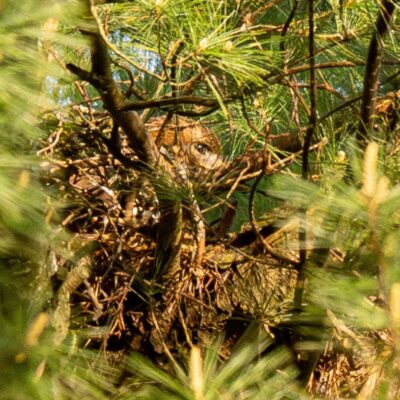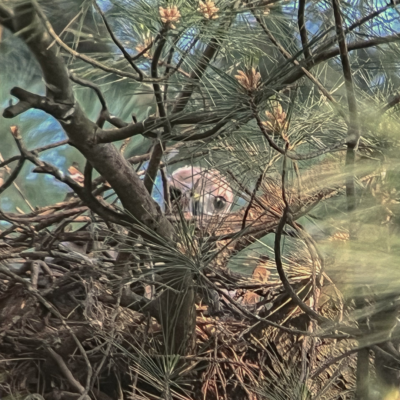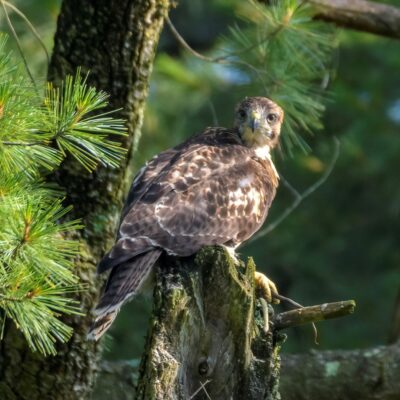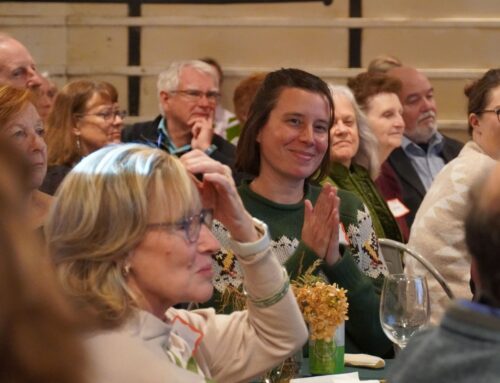In recent weeks, visitors to Tyler Arboretum have been hearing wild unearthly screams emanating from the trees in the area of the barn and Visitor’s Center.
Folks are often surprised when they learn that such loud and piercing calls are coming from two juvenile Red-tailed Hawks that were born this spring inside the arboretum.
Click below to hear the baby hawks.
The two youngsters hatched in a nest some 35 feet up in one of the large White Pines that are adjacent to the Fort Tyler Tree House. Their parents are most likely the same pair that has successfully nested in that tree for at least three consecutive years.
Participants in the weekly bird walks at Tyler were fortunate enough to witness the complete breeding cycle that produced these two healthy young hawks. We followed them all the way from the courtship of their parents in February to the young achieving independent flight in late June and July.
The Wednesday birders were able to document many of their observations with photographs. It was a privilege to have a front row seat to observe these magnificent creatures on their journey along this most basic of nature’s life cycles. Every species, plant or animal, has its own reproductive clock. Our little Red-tail family hit each milestone along the way in intervals precisely as predicted in the birding literature. Of course they did. That’s the way it’s supposed to work. But to witness it in real time was truly awe-inspiring.
The information about the breeding cycle presented in this blog was obtained from Birds of the World Online published by the Cornell Lab of Ornithology. Although this is a subscription publication, good information can be obtained without subscription on allaboutbirds.org, also published by Cornell.
Photos taken by Bob Bedell and David Eberly.
Courtship and Nest Building
On February 1, 2023 we were witness to a magnificent courtship ballet between two Red-tailed Hawks high over the meadows at Tyler.
The aerial pas de deux consisted of repeated circles, dives and swoops ending in the birds locking talons and a brief downward tumble of the locked birds until they separated, climbed again, and started over. The whole routine was repeated several times. It’s fairly safe to assume that this was the same pair that raised the brood we were able to follow through the spring.
Note the difference in size of the two birds. In many bird species, especially in raptors, the female is noticeably larger than the male. This is hard to discern unless they are seen next to each other. Also note the clean unbarred reddish tails. This tells us that these two are adults. You will see in later photos that the tails of the juveniles are pale with many narrow bars. Juvenile Red-tailed Hawks don’t attain an adult tail until their second summer.
Once paired, Red-tailed Hawks get busy selecting a nest site. They are known to work on 2-3 new or old nests at a time until they make a final selection. This year the pair used the same nest they used last year and probably the year before that.
Several times during March and April we witnessed the adults flying in and out of the tree. They were seen to carry sticks onto the nest and start busily arranging the material to their satisfaction.

An aerial courtship.
Brooding
On the left is a photo of one of the adults, most often it’s the female, sitting on the nest. The date of the image is May 12. We first saw a bird sitting on the nest on May 3rd. An attentive partner looked on from a nearby perch. The eggs are laid shortly after nest construction is completed. The incubation period from egg laying to hatching is 28-35 days. The babies had likely hatched at the time of this image.
On May 31 we saw a nestling peering over the edge of the nest. It was our first indication that breeding was successful. The photo on the right was taken on June 3. At that time the birds were moving around in the nest and it was apparent there were two babies. Nestlings are able to move around and stretch their wings by the time they are 30 days old.
Based on this behavior and given the incubation period of around 30 days, we can surmise that the eggs were laid around the first of April and hatching occurred around the first of May. Both parents will take part in feeding the young. We did observe an adult carrying a snake into the nest during this time.
Out of the Nest and Into the Air
Below are both of the babies on June 14. They are near but outside the nest. The books say the babies typically leave the nest 42-46 days after hatching so they are right on schedule. And they are growing up!
Young Red-tailed Hawks are capable of short flight about two and one-half weeks after they leave the nest. Here is one of the young birds on June 26. It’s at flying distance from, but still close, to the nest.
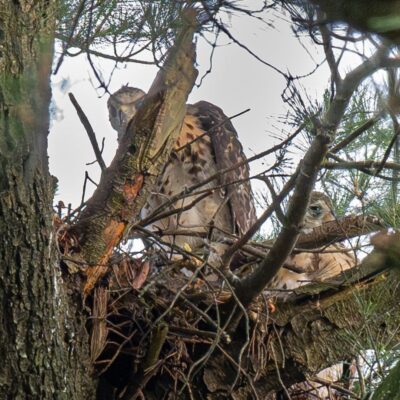
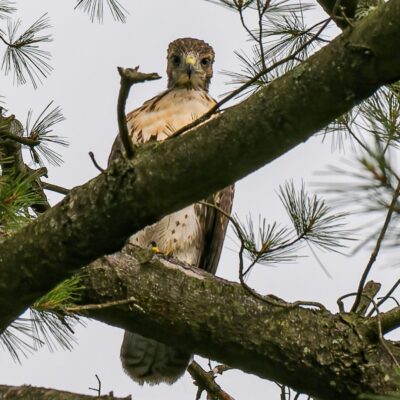
From here the young birds have to hone their flying and hunting skills. The parents will supplement their diet as they become more proficient. Young Red-tailed Hawks are said to remain associated with their parents for up to 10 weeks after they leave the nest. After that they are are out on their own.
Below are photos of the birds after they have achieved independent flight. The image on the left was taken on July 12 and the image on the right was taken July 26. They look like adults don’t they? However, look at their tails. They are pale and have fine horizontal bars in contrast to the unbarred reddish tails of the courting adults in the first photo of this article.
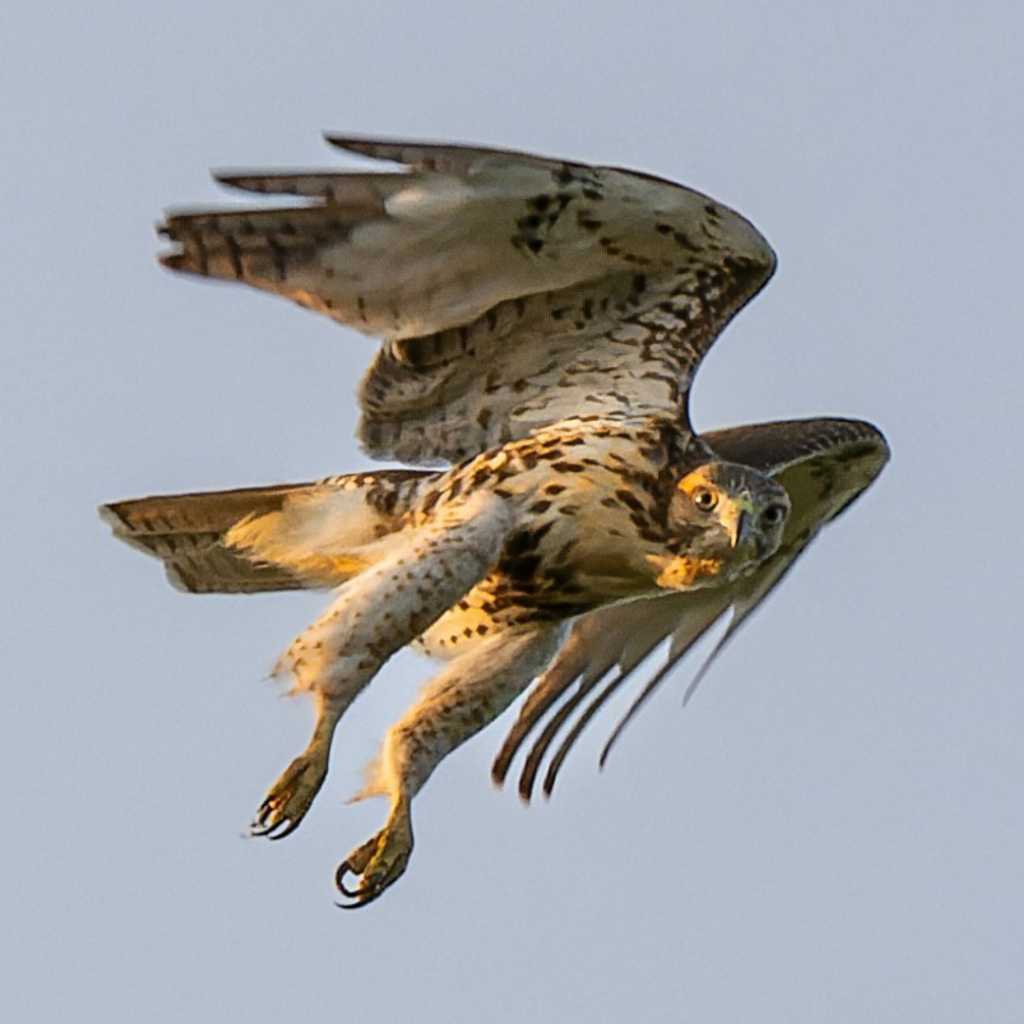
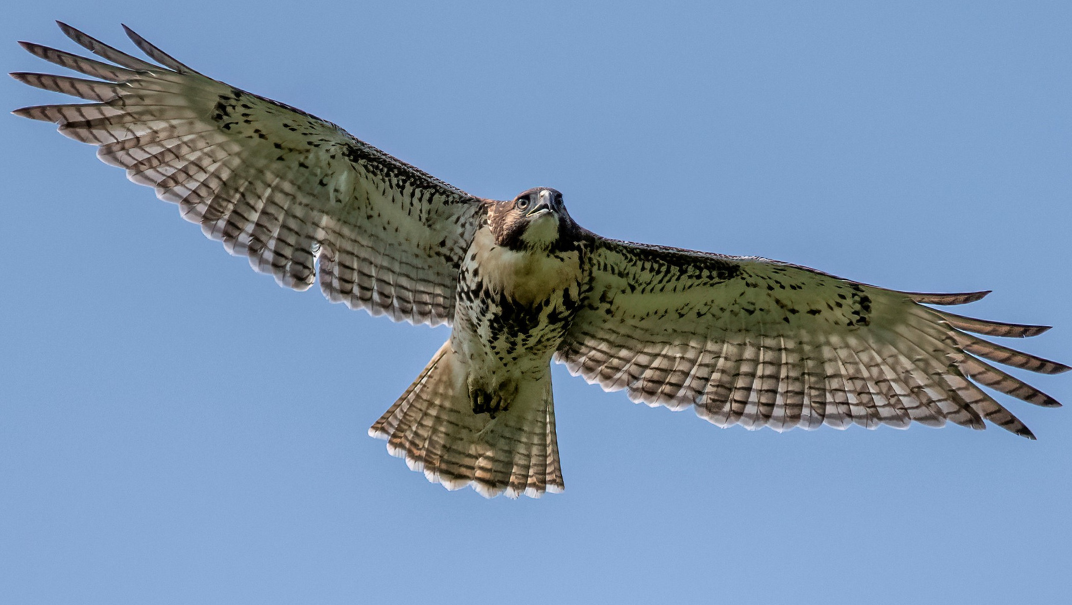
As of this writing on August 9 the young birds can still be found (and heard) in the arboretum.
Wish them well on their journey!


